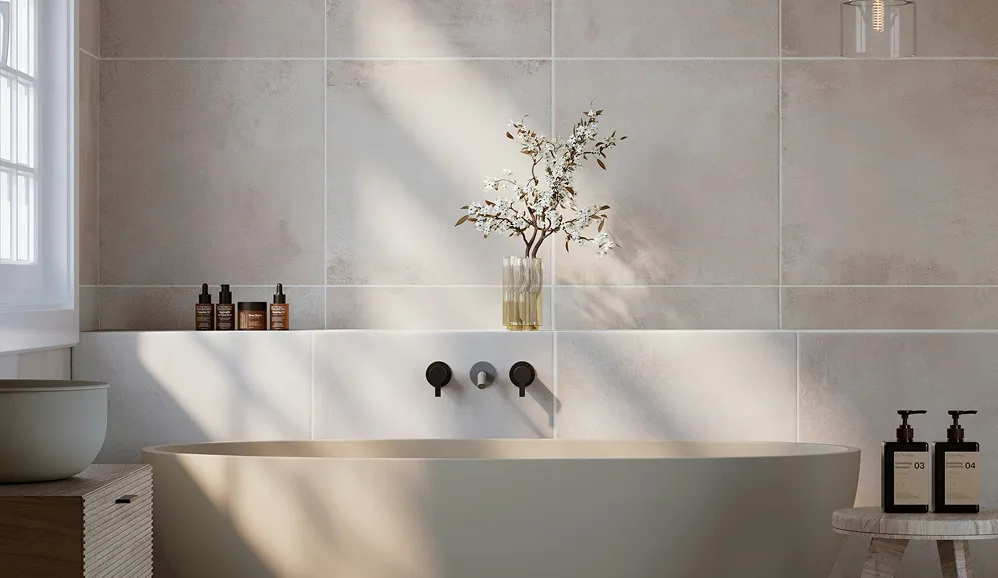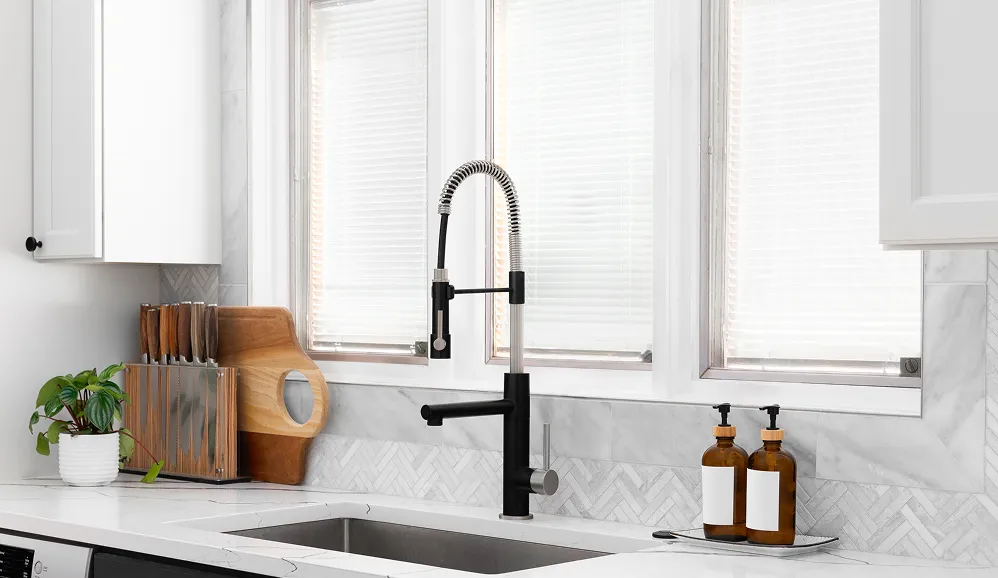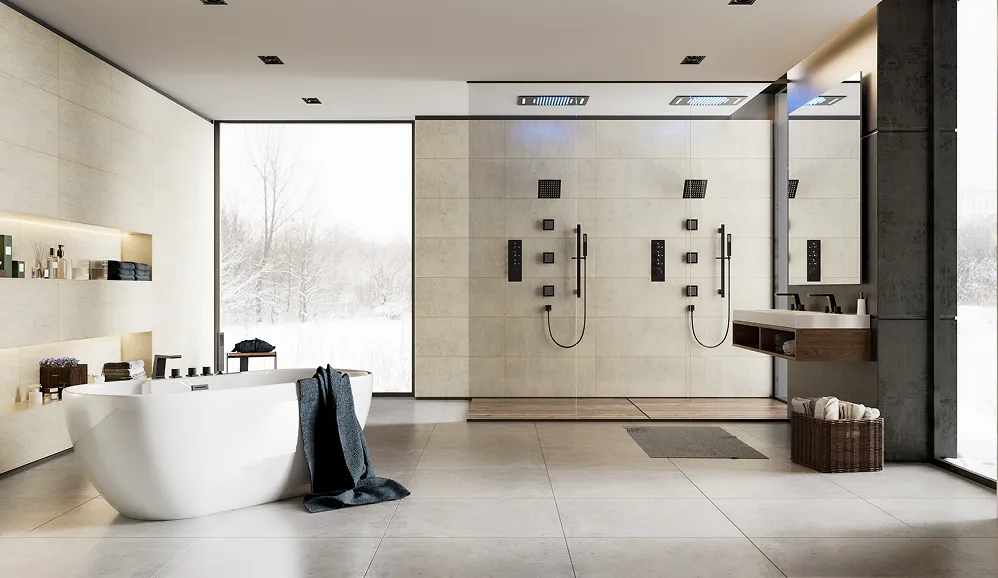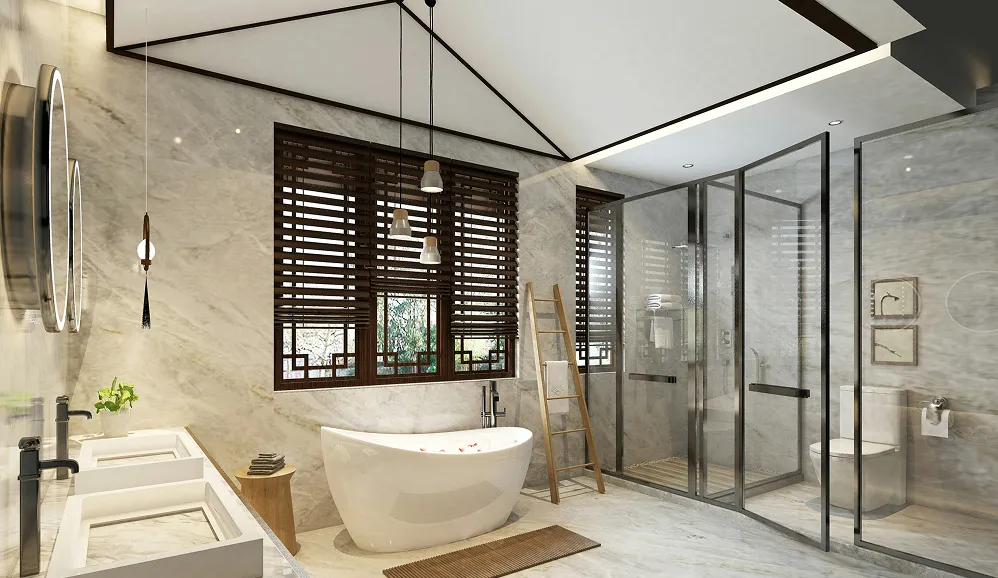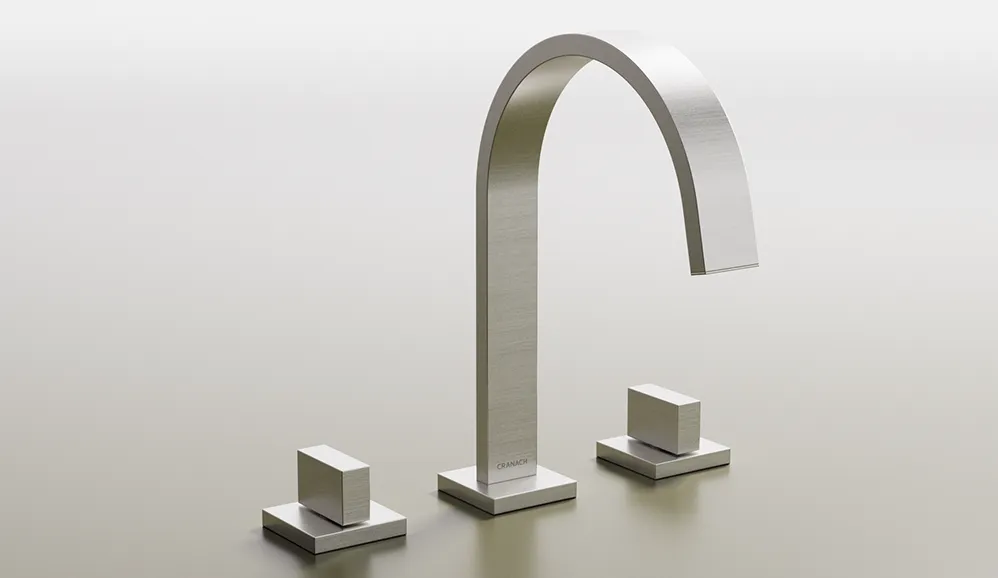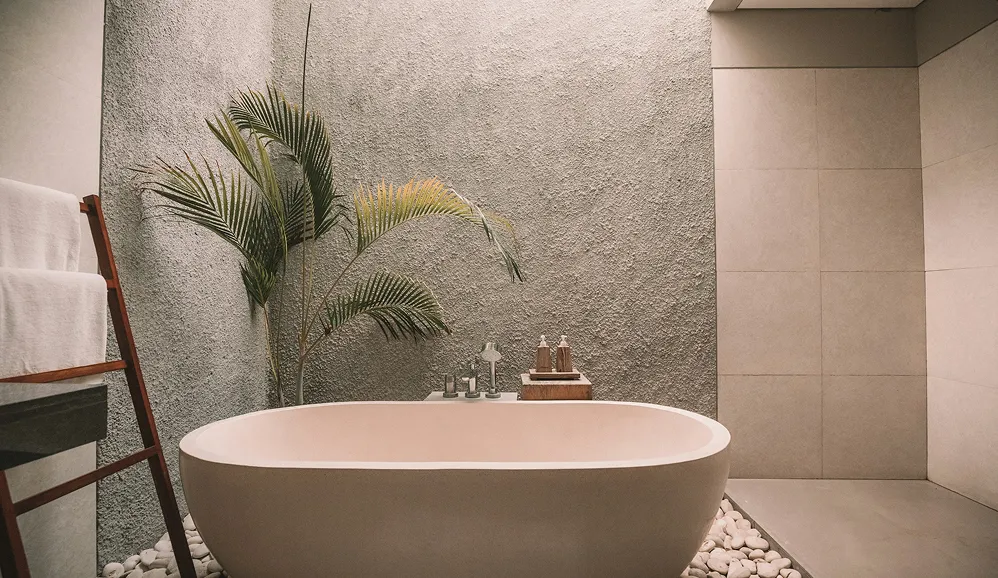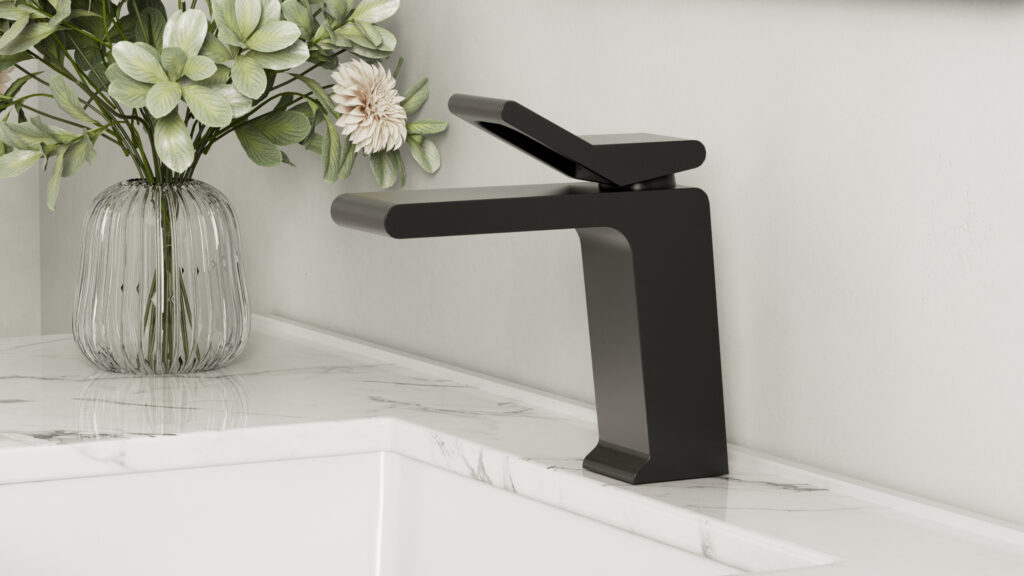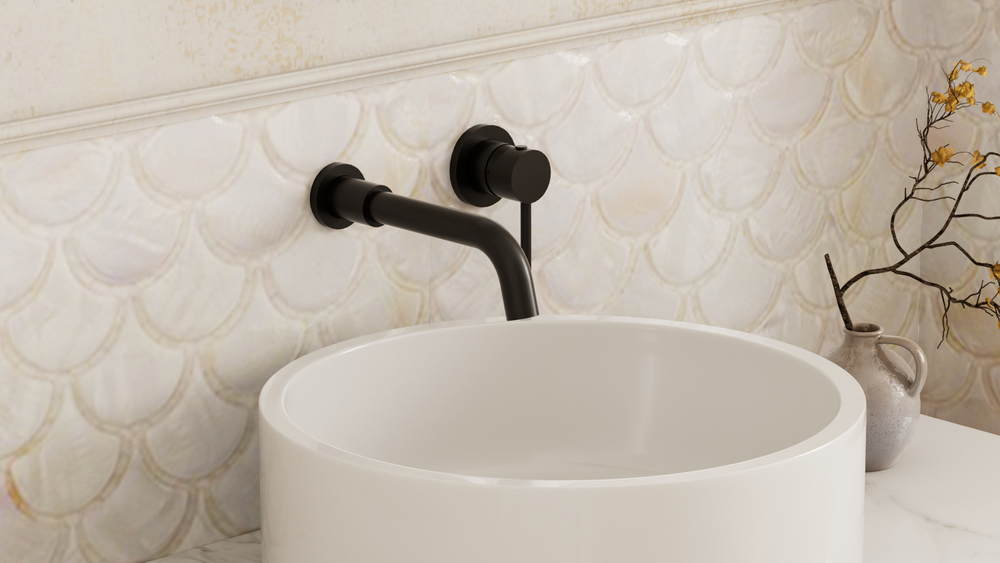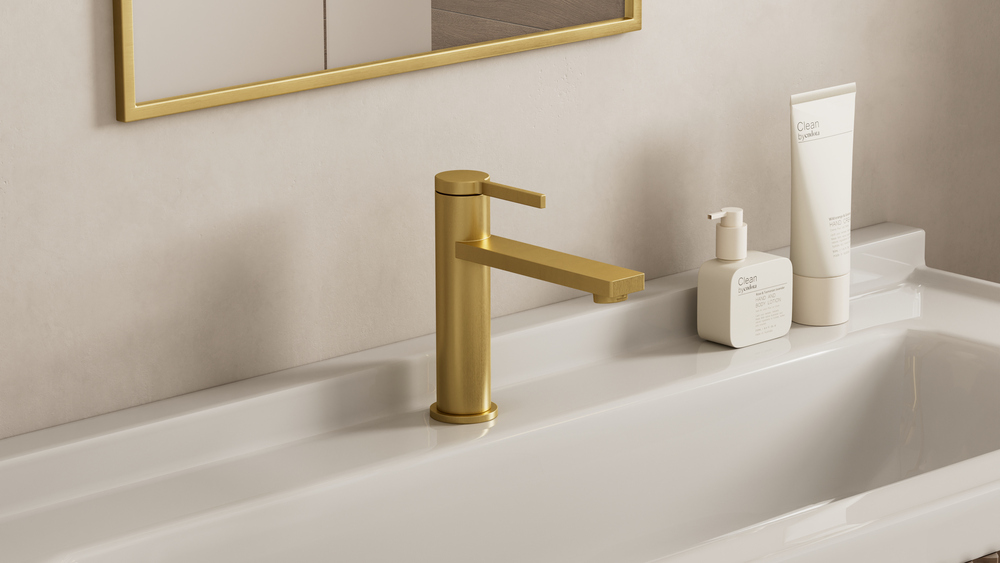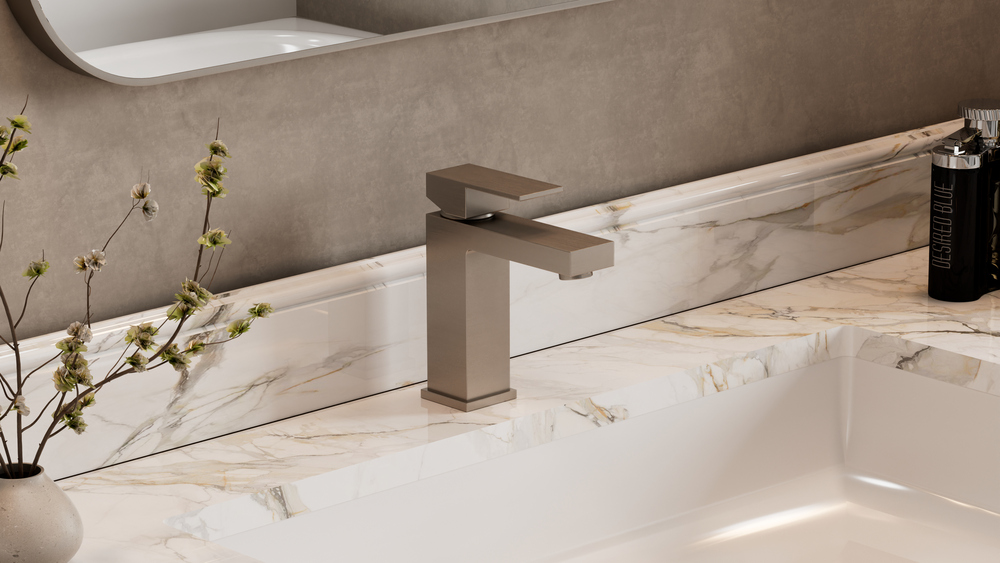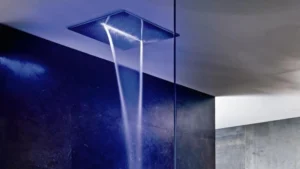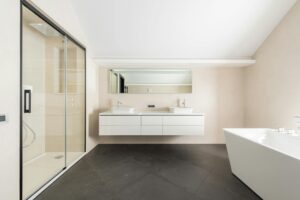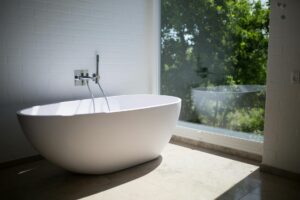Drip-Drop Gorgeous: Dive Into 2025’s Hottest Bathroom Faucet Trends
In 2025, bathroom faucet trends seamlessly blend innovative technology with beautiful aesthetics. Whether your style leans towards minimalist chic or lavish opulence, there’s a faucet trend ready to transform your bathroom.
From basic plumbing fixtures to the statement pieces we see today, the journey of the bathroom faucet reflects broader changes in design and technology. Initially, faucets prioritized function over form. However, as bathrooms evolved into spaces for relaxation and self-expression, faucets adapted as well, becoming key design features. The success of a modern faucet now depends on its ability to combine practicality and style, meeting user needs while making a strong visual statement.
Understanding Today’s Faucet Trends
Today’s homeowner, interior designer, contractor, or builder needs to understand these evolving trends. This isn’t just for aesthetics, but also to ensure optimal performance, water efficiency, and integration with smart home technology. In this article, we’ll explore ten bathroom faucet trends shaping 2025.
We’ll cover everything from finishes and configurations to technological advancements and emerging styles that will inspire your next bathroom project. Get ready to discover the ideal blend of form and function that will truly make your bathroom drip-drop gorgeous.
1. Matte Black Finishes
Matte black faucets have quickly become a mainstay in modern bathrooms. They offer a bold, sophisticated look compared to traditional chrome or brushed nickel. This growing trend highlights a shift toward contrasting design elements, with matte black often serving as a striking centerpiece. The non-reflective surface adds a unique visual texture, bringing depth and interest to any bathroom.
It complements various design aesthetics, from minimalist and industrial to even traditional spaces seeking a modern edge. A key practical benefit is its resistance to fingerprints, unlike glossy finishes, making it ideal for busy households.
The Rise of Matte Black
Several factors contributed to the rise of matte black. Design influencers, such as Joanna Gaines with her Magnolia Home designs and Nate Berkus, have showcased its versatile elegance. Recognizing the demand, leading manufacturers like many brands have expanded their product lines with extensive matte black collections. Social media platforms like Instagram and Pinterest have further solidified its popularity as a desirable bathroom feature.
Pros and Cons of Matte Black
This finish offers several practical advantages. In well-lit bathrooms, matte black creates a dramatic contrast, adding depth and visual appeal. It also effectively hides water spots and fingerprints, a frequent complaint with chrome. For a unified look, matte black seamlessly integrates with other black fixtures and hardware. Check out our guide on various finishes for more coordination ideas.
However, there are some potential drawbacks. While concealing water spots, matte black can sometimes highlight calcium buildup. Matte black finishes often carry a higher price compared to standard chrome or nickel.
Tips for Incorporating Matte Black
For those considering this stylish trend, here are some helpful tips:
- Maximize Contrast: Combine matte black faucets with white sinks for a timeless, high-contrast appearance.
- Coordinate Accessories: Extend the matte black to other hardware, such as towel bars, cabinet handles, and showerheads, for a cohesive design.
- Gentle Cleaning: Use non-abrasive cleaners to preserve the finish and prevent scratches.
- Consider Full Integration: For the greatest impact, incorporate black fixtures throughout the bathroom, including the shower and bathtub.
Matte black finishes have earned their spot on this list. They offer a stylish and modern update to a typically utilitarian fixture. By understanding the advantages, disadvantages, and implementation tips, homeowners, contractors, and designers can confidently embrace this trend to create a sophisticated and contemporary bathroom.
2. Smart Faucets With Touchless Technology
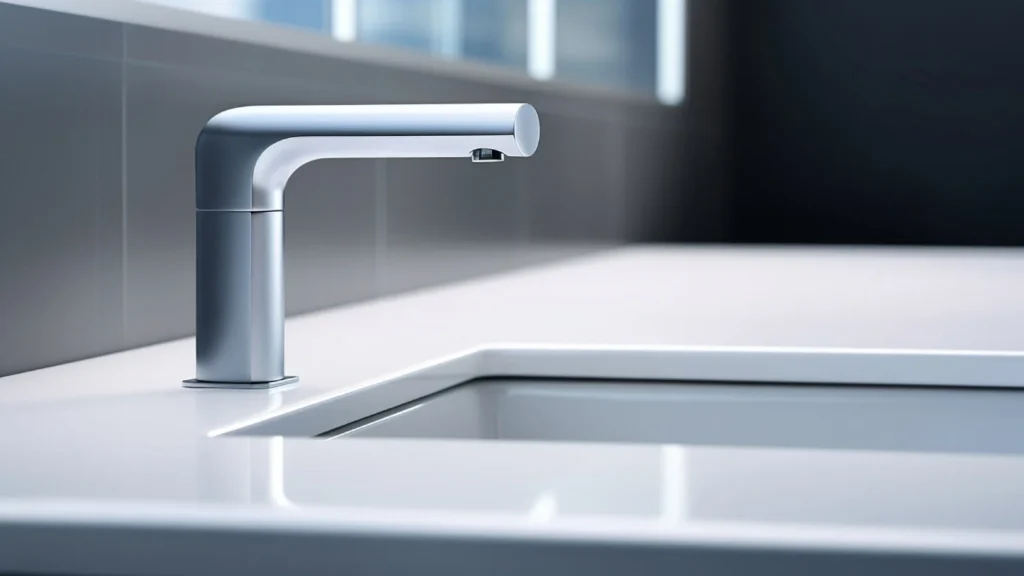
The growing popularity of smart home technology has boosted the adoption of smart faucets. As homeowners embrace interconnected devices and voice control, the bathroom is a natural place for this technology. Early adopters were attracted to the novelty and hygiene benefits. But decreasing prices and more features have made smart faucets appealing to a wider market. Smart faucets are no longer a luxury, but a practical upgrade for many homeowners.
Features and Benefits
These fixtures offer several advantages:
- Motion sensors for hands-free use
- Automatic shut-off to reduce water waste
- Temperature pre-setting for personalized comfort
Advanced models may include:
- Digital temperature displays
- Mobile app integration for remote control
- Voice control with systems like Amazon Alexa or Google Assistant
Imagine preheating your bath from your smartphone while still in bed or turning off the faucet with a voice command. These are just a few examples of what’s possible.
The improved hygiene of touchless operation is especially helpful for households with young children, elderly individuals, or people with mobility issues. Precise temperature control and automatic shut-off also save water, which is important for sustainable home design.
Drawbacks and Considerations
Smart faucets have some downsides:
- They cost more than traditional faucets.
- They require a power source (batteries or electricity).
- Installation can be complicated.
- Sensors may malfunction.
Examples of Smart Faucets
- Kohler Sensate with Kohler Konnect
- Moen U by Moen Smart Faucet
- Delta Touch2O Technology faucets
- American Standard Selectronic faucets
- Cranach Essential Line faucets
Tech-focused design firms are increasingly using smart faucets in modern bathrooms. Smart faucets are a significant advancement in bathroom technology, offering a combination of hygiene, convenience, and sustainability that appeals to homeowners and builders.
3. Wall-Mounted Faucets
Wall-mounted faucets are bringing a sleek, modern feel to bathrooms, offering a stylish alternative to traditional deck-mounted fixtures. By mounting directly to the wall above the sink, these faucets create a clean, minimalist aesthetic and free up valuable counter space. Inspired by European bathroom design, this trend has gained significant traction in contemporary and space-conscious homes.
The defining feature of a wall-mounted faucet is its spout, extending gracefully from the wall instead of the countertop. This unique design is usually paired with vessel or undermount sinks, further enhancing the minimalist appearance. Wall-mounted faucets are available in a variety of spout lengths and styles, ranging from sleek, geometric designs to more classic, curved forms. Often equipped with separate hot and cold handles, they offer precise temperature control and a touch of traditional charm. The rough-in valve, which controls the water flow, is concealed within the wall for a streamlined look.
Several factors contribute to the growing popularity of wall-mounted faucets. Designers like Philippe Starck championed this style, showcasing its potential in high-end European bathroom brands and luxury hotels. The minimalist design movement further fueled its adoption, with its emphasis on clean lines and uncluttered spaces.
Benefits of Choosing a Wall-Mounted Faucet
- Increased Counter Space: Removing the faucet base from the countertop creates significantly more usable space, a huge plus for smaller bathrooms.
- Simplified Cleaning: With no faucet base to clean around, wiping down the countertop becomes much easier.
- Design Statement: Wall-mounted faucets add a distinctive, modern touch, elevating the overall bathroom aesthetic.
- Ergonomic Flexibility: Installation at the ideal height provides adaptability for various sinks and user preferences.
- Concealed Plumbing: The hidden rough-in valve contributes to the clean, uncluttered appearance.
Drawbacks of Wall-Mounted Faucets
- Installation Complexity: Installing a wall-mounted faucet is more complex and expensive than installing a traditional faucet, typically requiring a professional plumber.
- Retrofit Challenges: Retrofitting can be challenging without access behind the wall.
- Maintenance Access: Accessing the plumbing for maintenance might require an access panel, adding to the initial installation expense.
- Limited DIY Potential: Due to the installation complexity, DIY projects are generally not recommended.
Examples of Popular Wall-Mounted Faucets
- Axor Citterio Wall-Mounted Faucet
- Kohler Purist Wall-Mount Faucet
- Hansgrohe Talis S Wall-Mounted Faucet
- Cranach Angelsey Wall-Mounted faucets
Wall-mounted faucets earn their spot on this list for their transformative power, turning bathrooms into modern, stylish, and functional spaces. Their distinct design and practical advantages make them an attractive option for those looking for a contemporary, space-saving solution.
4. Brushed Brass and Gold Finishes
The cool, sleek dominance of chrome and stainless steel in bathroom fixtures is fading. In its place, the warmth of brushed brass and gold is making a comeback. These finishes bring a touch of luxury and comfort, transforming the bathroom from a purely functional room into a relaxing retreat.
Their adaptability is a major draw, fitting seamlessly into both traditional and modern design aesthetics. This versatility has earned them a prime spot among the latest bathroom faucet trends.
Exploring the Range of Gold and Brass Finishes
From rich gold to subtle champagne, these finishes come in a variety of textures. This includes polished, satin, and brushed options. Brushed finishes are particularly in demand due to their ability to mask water spots and fingerprints. This makes them a practical choice for frequently used bathrooms. For added durability and resistance to tarnish and corrosion, many manufacturers use PVD (Physical Vapor Deposition) coating. This ensures the longevity of these luxurious finishes.
Pros of Brushed Brass and Gold
- Creates a Warm, Inviting Atmosphere: Gold and brass tones instantly add a welcoming feel and a touch of sophistication.
- Distinctive Alternative to Chrome: These finishes provide a stylish and unique alternative to the standard chrome fixtures.
- Complements Warm Color Palettes: They work beautifully with warm neutrals, earthy tones, and rich jewel tones.
- Adds a Luxurious Appearance: Gold and brass naturally evoke a sense of opulence, elevating the overall bathroom aesthetic.
- Brushed Finishes Hide Water Spots: This practical advantage makes brushed finishes a smart choice for busy bathrooms.
Cons of Brushed Brass and Gold
- Premium Price Point: These finishes typically come with a higher price tag than standard chrome or stainless steel.
- Potential for Water Spots (Polished Versions): Polished finishes require more frequent cleaning to maintain their shine.
- Risk of a Dated Look: Careful planning is crucial to ensure a timeless, rather than outdated, appearance.
- Finish Inconsistency Between Manufacturers: Slight variations in tone can occur between brands. Choose fixtures from the same manufacturer for a consistent look.
- May Require Special Cleaning Products: Avoid harsh abrasives and use gentle cleaners designed for these finishes.
Tips for Implementing Brass and Gold Finishes
- Coordinate with Accessories: Create a unified look by matching faucets with towel bars, robe hooks, and other accessories.
- Pair with White, Black, or Navy: These color combinations create a striking contrast and enhance the richness of the metallic finishes.
- Mix with Black Accents: Black accents add a touch of modern sophistication when combined with gold or brass.
- Use Mild Cleaners: This will help protect the finish and prevent scratches.
- Consider Brushed Finishes: Brushed finishes are less prone to showing water spots and fingerprints.
By understanding these finishes and following these practical tips, anyone can successfully incorporate the warmth and elegance of brushed brass and gold into their bathroom projects.
5. Single-Handle Waterfall Faucets
Single-handle waterfall faucets are rapidly becoming a fixture in modern bathrooms, transforming the everyday handwashing routine into a luxurious escape. Unlike their traditional counterparts, these faucets showcase a wide, open spout, allowing water to cascade elegantly downwards, much like a natural waterfall. This unique design adds a touch of sophistication and spa-like serenity to any bathroom.
The open-channel design, often featuring sleek metal or even glass, not only creates a visually appealing water flow but also enhances the soothing sounds of running water. This makes waterfall faucets a popular choice for those looking to create a relaxing ambiance. Some models even incorporate LED lighting for an extra touch of drama and atmosphere. The single-handle operation simplifies control of both water temperature and flow, adding to the overall user experience.
While aesthetically pleasing, there are practical factors to consider. Waterfall faucets often require higher water pressure to achieve the full cascading effect. For more information on water pressure and flow rates, see our guide on water flow rates. The wide spout can sometimes make it challenging to control the water flow precisely, potentially leading to splashing, particularly if the sink isn’t appropriately sized. The open channel, especially in designs with glass components, can also show mineral deposits in areas with hard water, requiring more frequent cleaning.
Pros and Cons of Waterfall Faucets
Pros:
- Dramatic visual effect and calming water sound
- Unique design adds a spa-like feel
- Serves as a striking design element, especially in guest bathrooms
- Simple single-handle operation
Cons:
- Potential for increased splashing
- Requires higher water pressure
- Can be challenging to direct water flow
- Susceptible to mineral buildup in hard water areas
- May require more cleaning
Tips for Installation and Maintenance
- Verify sufficient water pressure before installation
- Consider sink size and shape for optimal compatibility
- Consider water softeners in hard water areas
- Clean regularly to maintain appearance and prevent mineral deposits
The single-handle waterfall faucet earns its spot on this list for its ability to transform a basic bathroom fixture into a design statement. It perfectly captures the increasing desire to bring spa-like luxury into the home, appealing to homeowners seeking a modern, tranquil, and visually impressive bathroom.
6. Industrial-Style Exposed Pipe Faucets
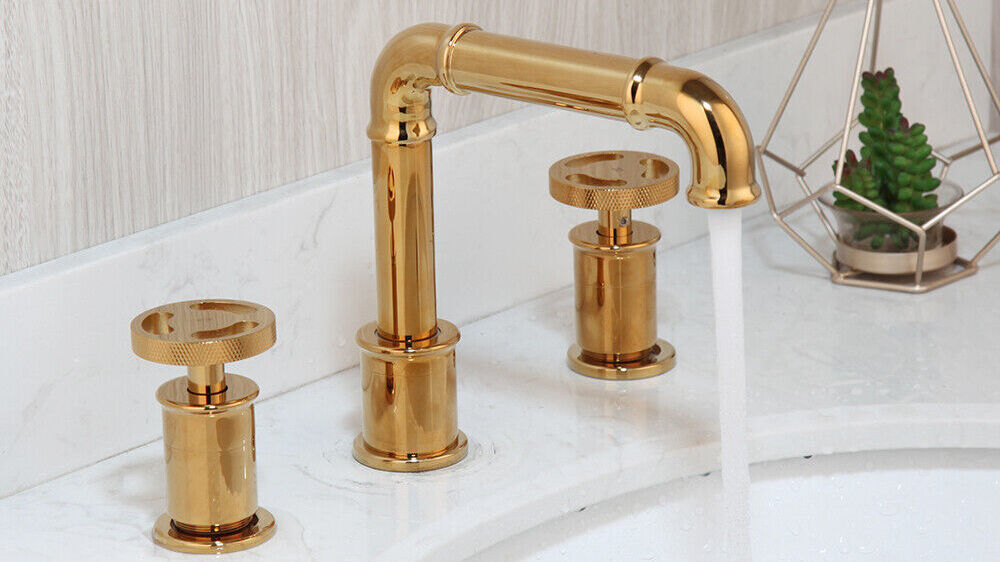
Industrial-style exposed pipe faucets have carved out a unique space in bathroom design. They offer a raw, utilitarian aesthetic that stands in stark contrast to sleek, modern minimalism. This design trend takes its cues from the functional designs found in early 20th-century factories and workshops. It celebrates the beauty of exposed mechanics and visible pipework.
Instead of hiding plumbing, industrial faucets put it on display, creating a striking focal point. This adds an authentic vintage or loft-inspired feel to any bathroom.
Distinctive Features of Industrial Faucets
- Prominent exposed pipework: Often made from materials like copper, brass, or blackened steel.
- Cross or lever handles: Featuring visible fasteners that amplify the industrial look.
- Taller design: Giving them a commanding presence in the bathroom.
- Raw or distressed finishes: Including brushed nickel, oil-rubbed bronze, or even unlacquered brass for an aged, authentic appearance.
- Mounting options: Typically deck-mounted, but some designs offer wall-mounted options for a more dramatic impact.
The appeal of these faucets lies in their distinct vintage character and robust construction. They are a perfect match for period renovations, blending seamlessly into bathrooms with exposed brick, reclaimed wood, or concrete elements.
Surprisingly, these faucets also complement a wide range of sink styles. They work well with vessel sinks, farmhouse sinks, and even more contemporary undermount options. Many industrial faucet designs incorporate visible temperature indicators, a clear nod to their utilitarian roots.
Considering the Drawbacks
While visually appealing, this style has some potential drawbacks:
- Cleaning: The exposed pipework and intricate details can be harder to clean than simpler, modern faucets.
- Limited Finishes: Finish options might be more restricted than with other styles.
- Bold Aesthetic: The strong, utilitarian look might not be suitable for minimalist bathrooms or those seeking a more understated design.
- Water Efficiency: Some industrial faucets may not include the water-saving features found in contemporary designs.
- Size: Their bulkier construction can feel overwhelming in smaller bathrooms.
Incorporating Industrial Faucets Effectively
To successfully incorporate industrial-style faucets, consider these tips:
- Complementary Elements: Pair them with other industrial elements like exposed brick or concrete walls.
- Sink Choice: Vessel or farmhouse sinks enhance the vintage vibe.
- Accessories: Extend the theme with pipe-inspired accessories, such as towel bars and toilet paper holders.
- Lighting: Vintage-inspired lighting fixtures complete the overall aesthetic.
- Balance: Soften the industrial look with contrasting textures and materials to prevent the space from feeling too harsh or cold.
7. Minimal Trough and Channel-Style Faucets
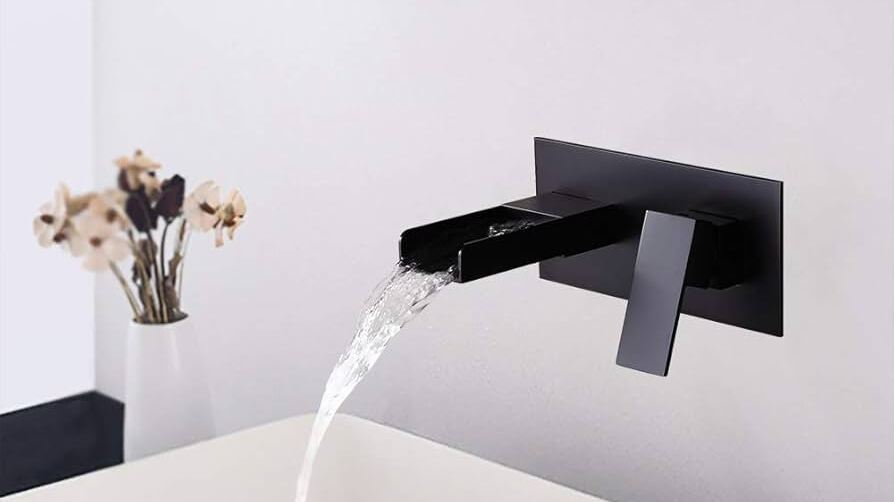
Minimalist trough and channel-style faucets are making a splash in modern bathrooms. They offer a sleek, architectural look compared to traditional faucet styles. These fixtures emphasize clean lines, geometric shapes, and simple materials, creating a visually striking effect. Instead of standard spouts, they use ultra-thin water channels, often built directly into the countertop or wall for a seamless and uncluttered look.
This trend shows a move towards fixtures that are as much sculptural pieces as they are functional. The minimalist philosophy also applies to the controls. They are often minimal, hidden, or seamlessly blended into the faucet design for an even more streamlined appearance. The lack of visible mechanical parts adds to the overall feeling of purity and simplicity.
Features and Benefits
- Ultra-thin Water Channels: These create a unique visual focal point and contribute to the minimalist aesthetic.
- Integrated Design: Often seamlessly incorporated into the countertop or wall for a clean, unbroken look.
- Minimal/Concealed Controls: Enhance the streamlined look and minimize visual clutter.
- Linear, Geometric Forms: Add a sense of architectural precision and modern style.
- Easier Cleaning: The flat surfaces of trough faucets are much simpler to clean than traditional faucets with complex curves and crevices.
- Maximizes Space: Ideal for smaller bathrooms, as the sleek design creates a feeling of spaciousness.
Real-World Examples and Evolution
The trend toward minimalist trough faucets gained popularity thanks to the influence of Italian design houses and minimalist architects, especially in high-end European bathroom design. For example, showcases this trend with its sleek, rectangular shape and built-in water channel.
Pros and Cons
Pros:
- Creates a clean, uncluttered aesthetic
- Makes a bold architectural statement
- Easier to clean than traditional faucets
- Works well in contemporary designs
- Maximizes visual space in small bathrooms
Cons:
- Often requires custom installation and precise plumbing
- Limited adjustability of water flow and temperature control in some designs
- Higher price point compared to conventional faucets
- Can require special maintenance because of the integrated design
Practical Tips for Implementation
- Plan Installation Carefully: Correct drainage angles are essential for optimal performance. Talk to a qualified plumber early in the planning process.
- Consider Professional Design Consultation: A designer can help integrate the faucet seamlessly into your overall bathroom design.
- Pair with Minimalist Sinks: A cohesive look is achieved by pairing trough faucets with similarly minimalist sinks.
- Use in Powder Rooms for Maximum Impact: Powder rooms offer a perfect opportunity to showcase the unique design of these faucets.
- Keep Surrounding Elements Simple: Avoid cluttering the area around the faucet to let it be the focal point.
This trend deserves to be on this list because it represents a significant shift away from traditional faucet design. It provides a fresh and innovative approach to bathroom fixtures. The higher price and specialized installation are factors to think about. However, the unique aesthetic and functional benefits of minimalist trough and channel-style faucets make them a growing choice for those seeking a modern and stylish bathroom design.
8. Mixed Metal Finishes
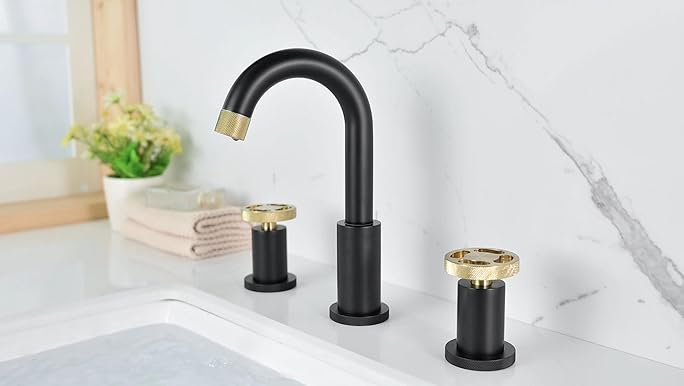
Gone are the days of matching every metal fixture in your bathroom. The mixed metal finishes trend embraces intentional contrast and personalized design, creating a rich, layered aesthetic that feels both curated and contemporary. Instead of appearing mismatched, this approach celebrates the interplay of different finishes, adding visual interest and depth.
This trend moves away from the traditional, uniform look by incorporating two or more metal finishes within the bathroom. Imagine brushed brass faucets paired with matte black showerheads, or polished nickel hardware alongside oil-rubbed bronze light fixtures. The key is intentional contrast—a strategic placement of different metals to create a harmonious, yet dynamic, visual experience. This often involves combining matte and polished finishes within the same metal family, or mixing warm metals like brass and copper with cooler tones like chrome and nickel.
Pros and Cons of Mixed Metal Finishes
| Pros | Cons |
|---|---|
| Visual Interest and Depth | Careful Planning Required |
| Personalized Expression | Complex Execution |
| Flexibility in Design Updates | Potential for Mismatched Look |
| Highlight Architectural Features | Replacement Parts May Be Challenging to Find |
| May Affect Resale Value |
Tips for Implementing Mixed Metal Finishes
- Limit the Palette: Choose 2-3 complementary finishes to avoid a visually overwhelming space.
- Dominant & Accent Finishes: Select one dominant finish and use the others as secondary accents.
- Warm & Cool Combinations: Pair warm metals (brass, copper) with cool metals (chrome, nickel) for balance.
- Create Rhythm: Repeat each finish at least twice to establish cohesion.
- Black as a Neutral: Black complements almost any metal finish.
Mixed metal finishes deserve recognition because they represent a significant shift in bathroom design. This trend allows homeowners and designers to move beyond traditional rules and embrace a more expressive, personalized approach. By understanding the principles of intentional contrast and following these tips, you can confidently incorporate this dynamic trend into your next bathroom project.
9. Wellness-Focused Faucets With Water Filtration
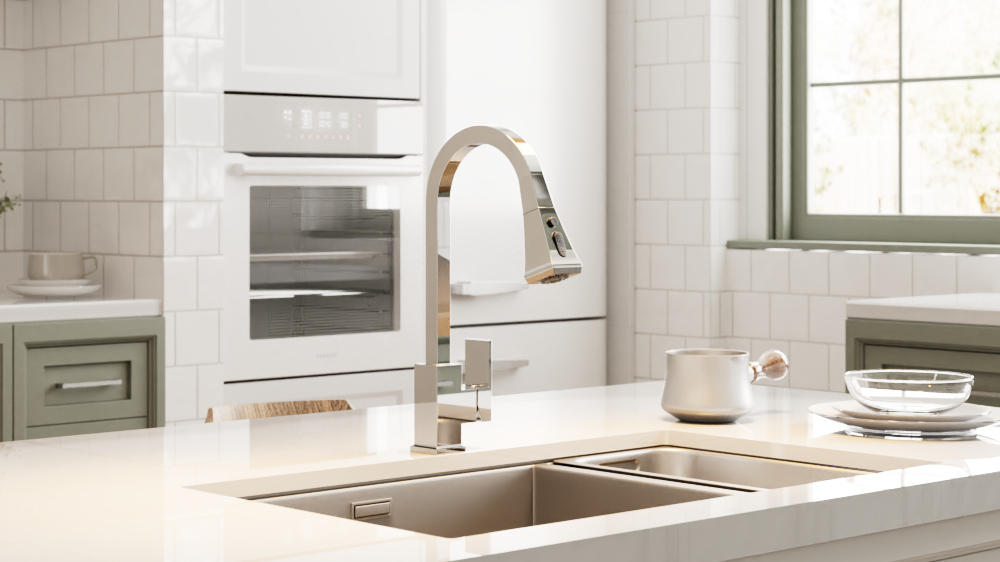
As our focus on health and wellness increasingly extends into our homes, the quality of our water becomes paramount. Wellness-focused faucets with integrated water filtration are transforming bathroom design. They address the growing demand for clean, readily available, contaminant-free water straight from the tap. This integration of health benefits and modern design makes them a practical and stylish upgrade.
These faucets go beyond standard fixtures. They deliver purified water specifically for daily routines like face washing and brushing teeth. By filtering out impurities like chlorine, lead, and other potential contaminants at the source, they promote healthier skin and improved oral hygiene. This also significantly reduces overall chemical exposure, a key benefit for those with sensitive skin or concerns about waterborne contaminants.
Features and Benefits
- Built-in Filtration Systems: Eliminating the need for bulky external filter pitchers or attachments.
- Certified Filters: Many models use NSF-certified filters, meeting stringent standards for contaminant removal. Look for certifications specific to your concerns, such as lead or chlorine reduction.
- Dedicated Dispensers: Some premium models feature separate dispensers, providing instant access to filtered drinking water.
- Filter Change Indicators: High-end options often include indicators that alert you when to replace the filter, maintaining optimal water quality.
- Multiple Filtration Levels: Select the filtration level that best addresses your needs and water quality concerns.
Pros
- Removes Contaminants: Effectively reduces or eliminates chlorine, lead, sediment, and other impurities.
- Sensitive Skin Friendly: Gentler water minimizes skin irritation.
- Space-Saving Design: Eliminates the need for separate filtration systems.
- Improved Taste: Enhances water taste for drinking and oral hygiene.
- Health Benefits: Reduces exposure to potentially harmful chemicals.
Cons
- Higher Initial Cost: Filtered faucets typically cost more upfront than standard faucets.
- Filter Replacements: Recurring expense for replacement filters.
- Complex Installation: Installation can be more involved due to the filtration components.
- Potential Water Flow Reduction: Filtration may slightly reduce water flow in some models.
- Under-Sink Space: The filtration system requires additional under-sink storage space.
Examples
- Kohler Aquifer Filtration System Faucet
- Moen Nurture filtered bathroom faucet
- ROHL Perrin & Rowe Filtration Faucet
- Cranach Filtered Bathroom Faucet
Tips for Implementation
- Research Filter Costs: Check replacement filter costs and availability before purchase.
- Measure Under-Sink Space: Ensure sufficient space for the filtration system.
- Easy Access Filters: Choose models with easily accessible filters for simplified replacement.
- Verify Certifications: Look for NSF/ANSI certifications for guaranteed filtration effectiveness.
- Holistic Wellness Approach: Combine a filtered faucet with other wellness features like aromatherapy diffusers or air purifiers.
The Rise of Filtered Faucets
Several factors have contributed to the increasing popularity of filtered faucets. The growing clean beauty movement, heightened awareness of environmental health, and the influence of wellness-focused designers and skincare specialists all play a role. As consumers prioritize health and wellness, the demand for filtered faucets will likely continue to grow.
10. Custom Artisanal and Handcrafted Faucets
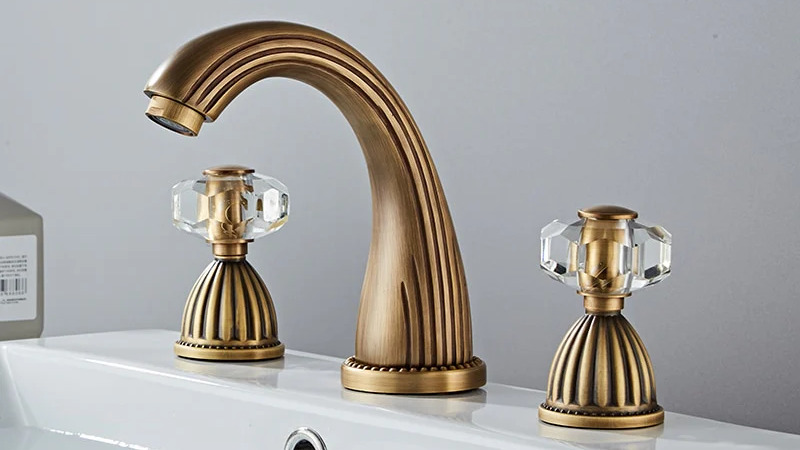
In bathroom design, the humble faucet has become a significant design element. The growing trend of custom artisanal and handcrafted faucets perfectly illustrates this shift. Moving away from mass-produced uniformity, these bespoke pieces reflect a desire for individuality, superior craftsmanship, and unique artistry in the bathroom. It’s part of a larger movement appreciating the beauty and story behind handmade items.
These aren’t merely faucets; they are functional works of art. Hand-finished details, unique textures, and often limited production runs or one-of-a-kind designs elevate these fixtures. Crafted from materials like solid brass, bronze, or copper, they might also incorporate unexpected elements like wood, stone, or glass, further personalizing the artistry. Custom patinas and living finishes add character, allowing the faucet to evolve over time, developing a rich, personal history.
The advantages of a handcrafted faucet go beyond aesthetics. Superior craftsmanship and quality mean greater durability and longevity, potentially making these pieces future heirlooms. Choosing an artisanal piece supports skilled craftspeople and preserves traditional metalworking techniques. Commissioning a custom faucet allows for complete design control, ensuring it fits your specifications and overall bathroom aesthetic. Check out our article about Cranach Tags Sitemap for more home improvement resources.
Tips for Choosing a Handcrafted Faucet
If you’re considering a handcrafted faucet, here are some practical tips:
- Budget Appropriately: Handcrafted quality requires investment.
- Plan Ahead: Account for longer lead times by ordering early.
- Design Cohesively: Consider the entire bathroom design for a balanced aesthetic.
- Research the Artisan: Learn about their background, experience, and materials.
- Understand Maintenance: Familiarize yourself with the care requirements for any living finishes.
By considering these factors, you can successfully incorporate a custom artisanal faucet into your bathroom, creating a space that reflects your style and appreciation for exceptional craftsmanship.
10 Bathroom Faucet Trend Comparison
| Trend | 🔄 Complexity | ⚡ Resources | 📊 Outcomes | Ideal Use Cases | ⭐ Advantages |
|---|---|---|---|---|---|
| Matte Black Finishes | Low – simple design update | Standard materials; moderate pricing | Dramatic contrast & modern aesthetic | Contemporary bathrooms, design-focused powder rooms | Bold impact; versatile pairing; fingerprint-resistant |
| Smart Faucets with Touchless Technology | High – sophisticated sensor systems | Requires batteries/electrical integration | Improved hygiene & water conservation | Tech-integrated homes, accessible modern bathrooms | Enhanced convenience; modern tech-forward design |
| Wall-Mounted Faucets | High – complex plumbing installation | Additional installation planning | Clean countertops & distinctive aesthetics | Space-conscious, contemporary bathrooms | Space-saving; sleek, modern look |
| Brushed Brass and Gold Finishes | Moderate – design-centric update | Premium pricing; special cleaning needed | Warm, luxurious ambience | Traditional or modern bathrooms seeking upscale details | Adds warmth; high-end, inviting appeal |
| Single-Handle Waterfall Faucets | Moderate – requires precise installation | May need higher water pressure | Striking waterfall effect; spa-like experience | Modern bathrooms with vessel sinks | Stunning visual flow; soothing water sound |
| Industrial-Style Exposed Pipe Faucets | High – non-standard installation | Specific plumbing modifications required | Authentic vintage, industrial character | Loft spaces, industrial conversions | Unique vintage character; robust design |
| Minimal Trough and Channel-Style Faucets | High – custom installation often needed | High-end materials and specialized setup | Sleek, architectural, uncluttered aesthetic | Contemporary, minimalist bathrooms | Bold design statement; easy-to-clean flat surfaces |
| Mixed Metal Finishes | Moderate – requires careful planning | Variable – often involves custom elements | Visually dynamic, curated, mixed finish look | Eclectic, design-forward interiors | Creates visual interest; personalized expression |
| Wellness-Focused Faucets with Water Filtration | High – integrated filtration technology | Higher cost with filter replacements | Enhanced water quality with health benefits | Health-conscious bathrooms; wellness-themed spaces | Multi-functional; improved water quality |
| Custom Artisanal and Handcrafted Faucets | Very High – bespoke design & installation | Highest due to artisanal craftsmanship & cost | Unique, one-of-a-kind functional art piece | Luxury bathrooms; statement, high-end design projects | Superior craftsmanship; exclusive, custom uniqueness |
Ready to Upgrade Your Flow?
From matte black minimalism to the luxurious gleam of brushed gold, 2025’s bathroom faucet trends offer diverse options for elevating your space. Whether your priority is touchless convenience, water-saving functionality, or a statement piece reflecting your unique style, the perfect faucet awaits. Key principles include balancing aesthetics with practicality, considering water efficiency, and ensuring compatibility with your existing plumbing and bathroom design.
Applying these principles involves careful planning. Start by defining your budget and desired functionality. Do you need a simple upgrade or a complete overhaul? Consider the size and style of your bathroom. A sleek wall-mounted faucet can save space in a smaller bathroom, while a dramatic waterfall faucet can become the focal point of a larger, more luxurious one. Don’t be afraid to mix and match finishes or incorporate emerging trends like mixed metals or wellness-focused features.
Staying Ahead of the Curve
The bathroom design world is constantly changing. Smart technology continues to advance, offering increasingly sophisticated touchless controls, personalized water temperature settings, and even leak detection. Smart home technology offers a wide range of possibilities. Sustainability remains a key driver, with new innovations focused on water conservation and eco-friendly materials. Staying informed about these ongoing trends and future developments will ensure your bathroom remains stylish and functional for years to come.
Key Takeaways:
- Functionality First: Prioritize features that meet your needs, such as touchless operation or water filtration.
- Style Matters: Choose a faucet that complements your overall bathroom aesthetic.
- Budget Wisely: Balance quality and affordability.
- Plan Ahead: Consider your existing plumbing and bathroom layout.
- Stay Informed: Keep up with emerging trends to future-proof your design.
Ready to transform your bathroom? Explore the collection of bathroom and kitchen faucets at Cranach and discover the perfect piece to elevate your space. From classic elegance to modern design, Cranach offers a wide range of high-quality faucets to suit every style and budget. Upgrade your flow and experience the difference Cranach quality can make. Discover the perfect faucet for your bathroom at Cranach

